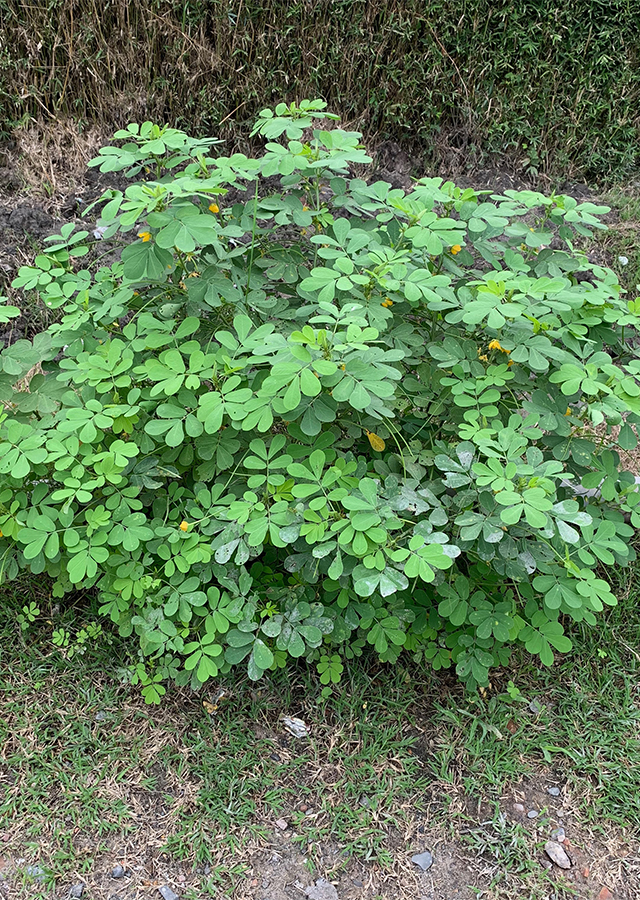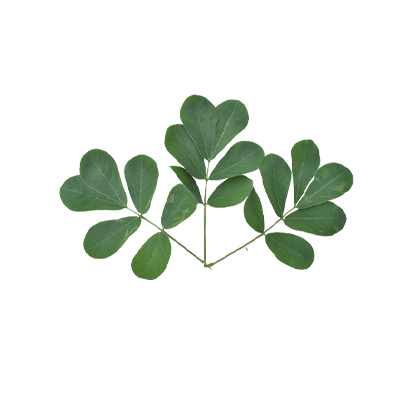Sickle senna
Senna tora (L.) Roxb.
Fabaceae
Location in our garden
Principal



Synonym
Cassia borneensis Miq.
Cassia contorta Vogel
Cassia foetida Salisb.
Habitus
Shrubs. Sickle senna is a small shrub that grows in warm, moist soil throughout Asia and Africa's tropical regions. A stout erect, smooth, rank-smelling, half-woody annual, 1 m or less in height.
Part Used
Leaves
Seeds
Fruit
Roots
Growing Requirements
Full Sunshine
Habitat
Riverbanks
Shrublands
Grassland
Overview
Sickle senna, which was originally native to the tropical Americas, has escaped from cultivation and become naturalized in a variety of tropical regions. It is edible and is used in traditional medicine. It is an annual to perennial plant with woody stems that can grow to be 2 metres tall. In oil palm plantations, it is used as a host for predators of pests.
Vernacular Names
Gelenggang kechil (Malaysia), Katanda (Philippines), d[aa]ng'hët khmaoch ni (Cambodia), Lap mun, Nha lap meun (Laos), Chum het tai (Thailand),Thảo quyết minh (Vietnamese).
Agroecology
Plants can grow in the tropics and subtropics. It grows on mountain slopes, wastelands, and river bank sands. Prefers a deep, well-drained, moderately fertile sandy loam and a position in full sun. At heights of up to 1,000 m, it is found mostly in waste ground, typically in dry to wet thickets, or as a weed in cultivated ground.
Morphology
- Leaves - 8 to 12 cm long and pinnately compound with 6 leaflets. Leaves are furnished with glands on the main rachis between leaflets. Leaflets are oblong-ovate or obovate and 2 to 5 cm long.
- Flowers - crowded, in pairs, in the axils of the upper leaves, and about 1.5 cm across. Calyx- tube is short, sepals are imbricate. Petals are 5, yellow, subequal. Stamens are 10, 3 to 5 being reduced to staminodes or sometimes absent, anthers mostly basifixed opening by terminal spores or with the slit more or less continuous downward. Ovary sessile or stalked.
- Fruits - slender pods, up to 15 cm long and 3 to 4 mm thick.
- Seeds - seeds are rhombohedral and brown in color, flattened in the same direction as the pod.
Cultivation
Propagation is by seeds. Pre-soaking for 12 hours in warm water, or abrading the seed with sand can improve germination rates and reduce germination time
Chemical Constituents
- Anthraquniones, glycoside, phytosterine, phenolic compound, tannins, flavonoids, steroids, saponins, chyzophanol, emodin, aloe-emodinrhein, physcion, obtusin, toralactone, aurant-onbtusin, rubrobusin, torachryson.
Traditional Medicinal Uses
- A decoction of the fruit is used in the treatment of fevers.
- The seeds have diuretic, laxative, and purgative properties. The raw seeds are used as a laxative, and the torrefied seeds are used to treat insomnia, headache, constipation, oliguria, cough, ophthalmia, dacryoliths, amblyopia, ocular congestion, and hypertension.
In Korea, the seed is used to treat constipation, oedema, glaucoma, nyctalopia, and liver protection.
In Nepal, a paste prepared from the seed is applied externally to treat leucoderma, leprosy, and itchy skin. - The leaves are purgative, they are used in the treatment of ringworm and skin diseases, also used as anthelmintic, and treatment against vomiting and stomach-ache
- The powdered leaves are used in the treatment of indigestion and stomach pain.
- The roots are used as a laxative and anthelmintic.
- A paste made from the roots, mixed with lemon juice (Citrus limon) is applied as a poultice to treat ringworm.
Part Used
Reference Sources
- Fern, Ken. (2014). Useful Tropical Plants. Senna tora. http://tropical.theferns.info/viewtropical.php?id=Senna+tora. (Accessed 06-02-2021).
- StuartXchange. (2016). Philippine Medicinal Plants. Katanda. http://www.stuartxchange.com/Katanda.html. (Accessed 06-02-2021).



